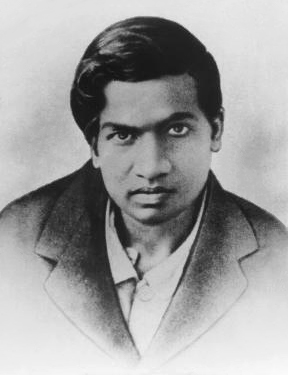Śrīnivāsa Rāmānujan: Difference between revisions
(New page created.) |
No edit summary |
||
| (22 intermediate revisions by 4 users not shown) | |||
| Line 1: | Line 1: | ||
{{Infobox person | |||
| name = Śrīnivāsa Rāmānujan | |||
| image = Srinivasa Ramanujan - OPC - 2 (cleaned).jpg | |||
| birth_date = 22 December 1887 | |||
| birth_place = Erode | |||
| death_date = 26 April 1920 (aged 32) | |||
| death_place = Kumbakonam | |||
| awards = Fellow of the Royal Society | |||
}} | |||
'''Śrīnivāsa Rāmānujan''' born '''Śrīnivāsa Rāmānujan Aiyangar''', (22 December 1887 – 26 April 1920)<ref>{{Cite web|title=Śrīnivāsa Rāmānujan|url=https://en.wikipedia.org/wiki/Srinivasa_Ramanujan}}</ref> was an Indian mathematician who lived during the British Rule in India. Though he had almost no formal training in pure [[mathematics,]] he made substantial contributions to mathematical analysis, number theory, infinite series, and continued fractions, including solutions to mathematical problems then considered unsolvable. | |||
== Contributions == | |||
'''Rāmānujan number''' :The number 1729. It is known as Rāmānujan number. It is the smallest [[number]] which can be expressed as the sum of two cubes in two different ways. | |||
1729 = 1<sup>3</sup>+ 12<sup>3</sup>= 9<sup>3</sup>+ 10<sup>3</sup> | 1729 = 1<sup>3</sup>+ 12<sup>3</sup>= 9<sup>3</sup>+ 10<sup>3</sup> | ||
'''Infinite Series for π'''<ref>{{Cite web|title=Srinivasa Ramanujan's Contributions in Mathematics|url=https://www.iosrjournals.org/iosr-jm/papers/Vol12-issue3/Version-4/O120304137139.pdf}}</ref> : Śrīnivāsa Rāmānujan discovered [[infinite series]] for π in1910 . The series <math>\frac{1}{\pi} = \frac{2\sqrt{2}}{9801}\sum_{k=0}^\infty \frac{(4k\mid)(1103+26390k)}{(k)^4\, 396^{4k}} </math> | |||
'''Theory of Equations''' : He derived the formula to solve biquadratic [[equations]]. | |||
'''Asymptotic Formula''' : He worked on partition of numbers. Using [[Partition function]] p(n) derived a number of formulae in order to calculate the partition of numbers | |||
<math>p(n)\thicksim \frac{1}{4n\sqrt{3}} e^\pi\sqrt{\frac{2n}{3}} , n\rightarrow\infty </math> | |||
'''Ramanujan's magic square :''' | |||
{| class="wikitable" | |||
|+ | |||
|22 | |||
|12 | |||
|18 | |||
|87 | |||
|- | |||
|88 | |||
|17 | |||
|9 | |||
|25 | |||
|- | |||
|10 | |||
|24 | |||
|89 | |||
|16 | |||
|- | |||
|19 | |||
|86 | |||
|23 | |||
|11 | |||
|} | |||
* Sum of numbers of any row is 139 | |||
* Sum of numbers of any column is 139 | |||
* Sum of numbers of any diagonal is 139 | |||
* Sum of corner numbers is 139 | |||
*Top row represents the date of birth '''Rāmānujan''' | |||
'''Ramanujan’s Congruences :''' | |||
He discovered the congruences | |||
<math>p(5n+4) \equiv 0(mod \ 5)</math> | |||
<math>p(7n+5) \equiv 0(mod \ 7)</math> | |||
<math>p(11n+6) \equiv 0(mod \ 11),\forall n \in N</math> | |||
== See Also == | |||
[[श्रीनिवास रामानुजन्]] | |||
== External Links == | |||
* [https://mathshistory.st-andrews.ac.uk/Biographies/Ramanujan/ Ramanujan] | |||
* [https://ia903003.us.archive.org/30/items/arxiv-math0003184/math0003184.pdf Life and work of the Mathemagician Srinivasa Ramanujan] | |||
== References == | |||
<references /> | |||
[[Category:Articles with hCards]] | |||
[[Category:CS1 français-language sources (fr)]] | |||
[[Category:CS1 maint]] | |||
[[Category:CS1 Ελληνικά-language sources (el)]] | |||
[[Category:Citation Style 1 templates|W]] | |||
[[Category:Collapse templates]] | |||
[[Category:Indian Mathematicians]] | |||
[[Category:Mathematics]] | [[Category:Mathematics]] | ||
[[Category: | [[Category:Navigational boxes| ]] | ||
[[Category:Navigational boxes without horizontal lists]] | |||
[[Category:Organic Articles English]] | |||
[[Category:Pages with script errors]] | |||
[[Category:Sidebars with styles needing conversion]] | |||
[[Category:Template documentation pages|Documentation/doc]] | |||
[[Category:Templates based on the Citation/CS1 Lua module]] | |||
[[Category:Templates generating COinS|Cite web]] | |||
[[Category:Templates generating microformats]] | |||
[[Category:Templates that are not mobile friendly]] | |||
[[Category:Templates used by AutoWikiBrowser|Cite web]] | |||
[[Category:Templates using TemplateData]] | |||
[[Category:Wikipedia fully protected templates|Cite web]] | |||
[[Category:Wikipedia metatemplates]] | |||
Latest revision as of 14:41, 29 November 2022
Śrīnivāsa Rāmānujan | |
|---|---|
 | |
| जन्म | 22 December 1887 Erode |
| मर गया | 26 April 1920 (aged 32) Kumbakonam |
| पुरस्कार | Fellow of the Royal Society |
Śrīnivāsa Rāmānujan born Śrīnivāsa Rāmānujan Aiyangar, (22 December 1887 – 26 April 1920)[1] was an Indian mathematician who lived during the British Rule in India. Though he had almost no formal training in pure mathematics, he made substantial contributions to mathematical analysis, number theory, infinite series, and continued fractions, including solutions to mathematical problems then considered unsolvable.
Contributions
Rāmānujan number :The number 1729. It is known as Rāmānujan number. It is the smallest number which can be expressed as the sum of two cubes in two different ways.
1729 = 13+ 123= 93+ 103
Infinite Series for π[2] : Śrīnivāsa Rāmānujan discovered infinite series for π in1910 . The series
Theory of Equations : He derived the formula to solve biquadratic equations.
Asymptotic Formula : He worked on partition of numbers. Using Partition function p(n) derived a number of formulae in order to calculate the partition of numbers
Ramanujan's magic square :
| 22 | 12 | 18 | 87 |
| 88 | 17 | 9 | 25 |
| 10 | 24 | 89 | 16 |
| 19 | 86 | 23 | 11 |
- Sum of numbers of any row is 139
- Sum of numbers of any column is 139
- Sum of numbers of any diagonal is 139
- Sum of corner numbers is 139
- Top row represents the date of birth Rāmānujan
Ramanujan’s Congruences :
He discovered the congruences